Hanse 430e
January 2008
Stylish cruiser pushes the comfort and speed envelope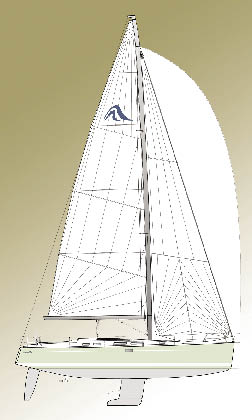
Hanse is breaking all the rules. You can't build a cruising boat with an open transom, and a sleek modern interior. You can't build a midsize cruiser with a rig over 65 feet tall. Or can you?
Hanse has been steadily and stealthily growing since starting production in 1993. It is a young company, but the Hanse factory in Germany, located along the Baltic coast in a town called Greifswald, is on the site of a boatyard that has been building boats since 1361. Hanse currently builds eight top-quality models from 32 to 63 feet, designed by the venerable Judel/Vrolijk & Co. design firm. In the last few years, Hanse has been making a big splash in the American yacht market. I recently had the chance to sail the Hanse 430e on a blisteringly hot fall day in Annapolis, with typical Chesapeake Bay weather and variable 5- to 10-knot winds.
The details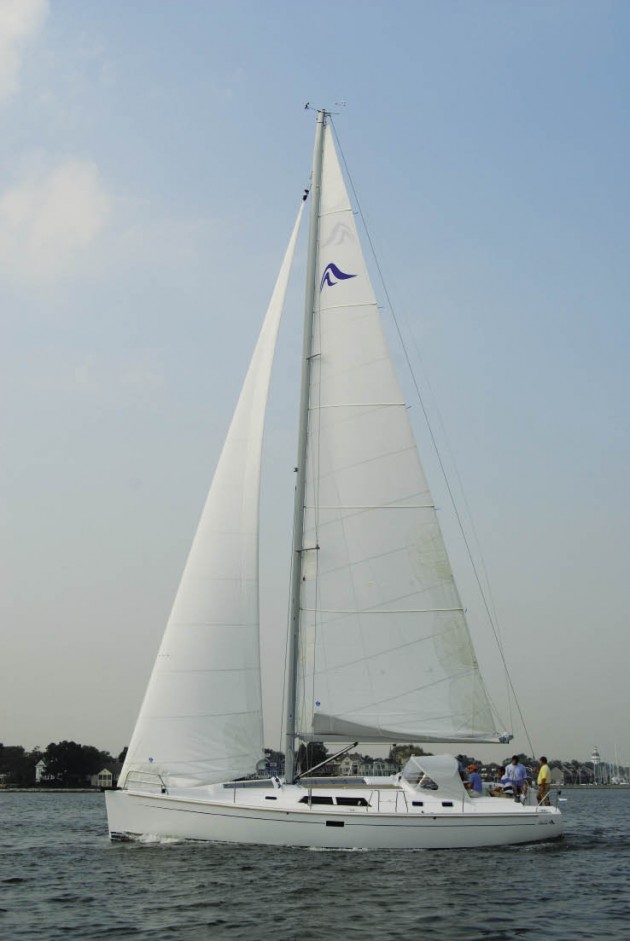 The standard hull on the Hanse 430 is cored fiberglass with foam below the waterline and balsa above, the deck is also cored with balsa. The hull can be built with vacuum-bagged epoxy as an option (430e). Vacuum bagging allows a uniform resin distribution and keeps the resin-to-fiberglass cloth ratio very low. The epoxy hull is 20-percent lighter and much stronger and stiffer than a traditional fiberglass hull.
The standard hull on the Hanse 430 is cored fiberglass with foam below the waterline and balsa above, the deck is also cored with balsa. The hull can be built with vacuum-bagged epoxy as an option (430e). Vacuum bagging allows a uniform resin distribution and keeps the resin-to-fiberglass cloth ratio very low. The epoxy hull is 20-percent lighter and much stronger and stiffer than a traditional fiberglass hull.
Either hull is stiffened with a grid structure of fiberglass floors and stringers. The bulkheads are tabbed to the hull and deck to further stiffen the whole unit. An iron keel is standard, and an iron/lead composite keel that uses lead as ballast and iron in the keel strut, which lowers the center of gravity, is an option. The performance keel is a deep 7 feet, 3 inches and a shallow draft model is available at 5 feet, 11 inches.
The rudder is attached with an aluminum stock and supported by self-aligning needle bearings. Interestingly, the aluminum web inside the rudder is not welded, but drilled and glued together. Hanse uses Jefa shaft drive steering on all of the boats.
On deck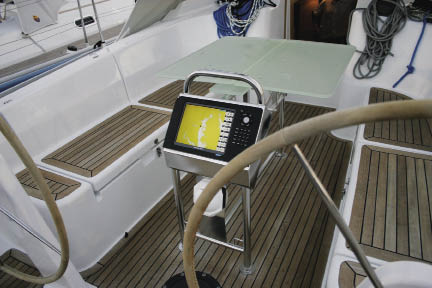 The cockpit is truly innovative. Your eye is immediately drawn to the dual helm stations and the open transom. The transom gives the boat a very sporty look and feel, but optional helm seats are available. The after end of the cockpit serves as the swim platform and there is a flush-mounted shower. Forward of the helm is a frosted acrylic folding table, and the material really has a modern look. There is a stout welded stainless steel instrument housing at the aft end of the table.
The cockpit is truly innovative. Your eye is immediately drawn to the dual helm stations and the open transom. The transom gives the boat a very sporty look and feel, but optional helm seats are available. The after end of the cockpit serves as the swim platform and there is a flush-mounted shower. Forward of the helm is a frosted acrylic folding table, and the material really has a modern look. There is a stout welded stainless steel instrument housing at the aft end of the table.
All of the control lines are led aft to the cockpit under fiberglass decks. The furling drum and line are mounted under the deck as well. The entire deck is clean and uncluttered. The boat comes with a standard single-line mainsail reefing system, solid boom vang and backstay adjuster.
The 9/10-fractional deck-stepped rig is tapered and sports double spreaders. The standard full-batten main has two reefs and is handled with a lazy jack system and integral cover. The jib is self-tacking with a traveler arrangement on the foredeck. The rig design was not limited by the 65-foot ICW bridge height restrictions. "We didn't let the Army Corps of Engineers design our rig," said a Hanse rep.
There is a single anchor roller with a self-draining locker, with access via a lockable door on the foredeck. Storage in the cockpit is reasonable, with a single large locker. The deck is easy to maneuver with stout stainless handrails. All the deck hardware is top quality.
Down below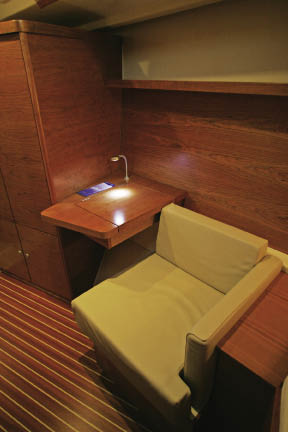
 The interior cosmetic design of the Hanse 430e is very nontraditional. I really liked the fresh, clean look; part artful design and part European practicality.
The interior cosmetic design of the Hanse 430e is very nontraditional. I really liked the fresh, clean look; part artful design and part European practicality.
The color options down below are nearly endless. There are two wood choices: a dark, satin-finished mahogany or a lighter satin-finished American cherry. Both are paired with white laminate bulkheads for a bright, airy look. There are 16 different fabric options, enough to satisfy anyone's taste. Speaking of color options, the hull is available in seven different colors, and there are eight colors available
in the selection for the boot and cove stripes.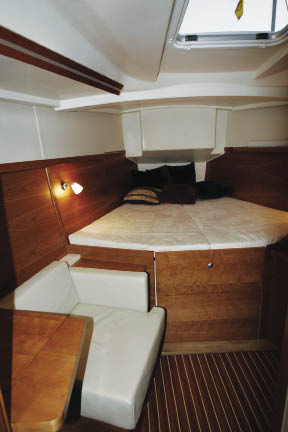 The options don't stop with colors, Hanse offers a lot of customization in cabin layout with what it calls the Hanse Individual Cabin Concept. The company essentially divides the boat up into three sections, the bow section forward of the mast, the saloon and the aft cabin. There is an option of a single aft quarter cabin and a large lazarette, or mirror-image single quarter cabins on port and starboard. There are three different forward cabins available. A forward-facing double bunk tucked up into the bow, an aft facing double bunk, a forward facing double with twin over/under singles, and an option to divide the single bunks off into a small forward quarter cabin. All of the forward cabin options have a large head with a separate shower area.
The options don't stop with colors, Hanse offers a lot of customization in cabin layout with what it calls the Hanse Individual Cabin Concept. The company essentially divides the boat up into three sections, the bow section forward of the mast, the saloon and the aft cabin. There is an option of a single aft quarter cabin and a large lazarette, or mirror-image single quarter cabins on port and starboard. There are three different forward cabins available. A forward-facing double bunk tucked up into the bow, an aft facing double bunk, a forward facing double with twin over/under singles, and an option to divide the single bunks off into a small forward quarter cabin. All of the forward cabin options have a large head with a separate shower area.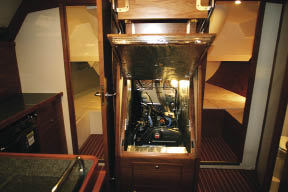
The saloon is very practical and tastefully designed. The galley is at the base of the companionway on starboard. The L-shaped space features a double-burner stove and a top- and front-loading refrigerator. The countertops are covered in a beautiful, stone gray, solid surface material. The tops have a wooden fiddle edge and very practical stainless steel handrail. There are many cabinets and drawers throughout the galley space, giving plenty of room to organize all of your cookware, dishes and gadgets-as the Hanse brochure states, "there is an essential need for order, especially in the galley."
To port, there is a large head compartment with a separate shower stall. The entire head area is molded fiberglass and the shower area features a seat and door. There is plenty of storage in the head with cabinets both above and below the sink area.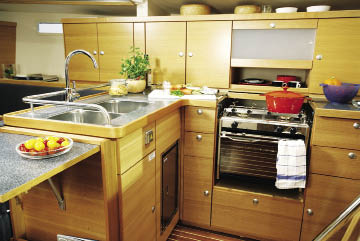
Forward of the galley there is large U-shaped dining area with a storage area outboard. The table has wine bottle storage in the base with access via a removable frosted acrylic panel in the tabletop. There are large drawers below the dining table seats, giving full access to the storage without the need to remove the cushions-a nice touch.
Opposite the dining table is a settee and nav station. The nav station consists of a large flip-top table and cabinets above. The table can easily be used for charts, games or a laptop computer. The cabinet above houses the navigation instruments. With the doors folded open you have a traditional nav station, with the doors closed the area takes on the personality of a casual sitting area.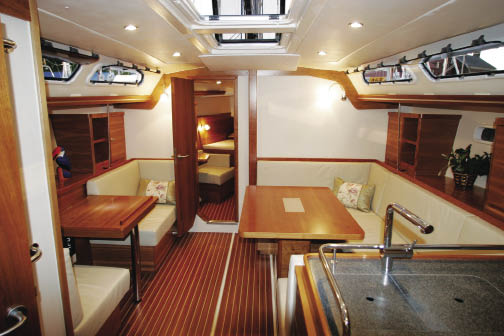 In the interest of keeping the boat as light as possible, the passage doors use a foam sandwich construction. To save weight and provide durability the cabin sole is synthetic.
In the interest of keeping the boat as light as possible, the passage doors use a foam sandwich construction. To save weight and provide durability the cabin sole is synthetic.
Cabin ventilation is reasonable with several opening portlights and a couple of overhead hatches. An 80-amp-hour start battery and 110-amp-hour house battery are standard. Total water capacity is 320 liters, or about 85 gallons, and fuel capacity is 200 liters, or 53 gallons.
A Yanmar 3JH4, 40-horsepower diesel, with a saildrive and two-blade fixed prop, is standard. A larger Yanmar 4JH4, 55-horsepower diesel is optionally available. The engine is accessible from behind the companionway stairs and through panels in the aft cabin.
Underway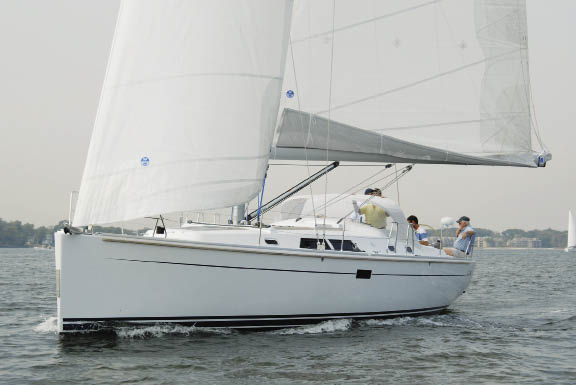 The fluky Chesapeake winds made sailing difficult, but the tall rig of the 430 was able to generate some power. We sailed along on a broad reach at roughly 6 knots. Coming up on the wind the boat sailed true and accelerated nicely in what puffs we could find. The self-tacking jib was a joy, the entire tacking operation consisted of cranking the wheel over. The boat pivoted smartly on its keel and quickly accelerated off on the new tack.
The fluky Chesapeake winds made sailing difficult, but the tall rig of the 430 was able to generate some power. We sailed along on a broad reach at roughly 6 knots. Coming up on the wind the boat sailed true and accelerated nicely in what puffs we could find. The self-tacking jib was a joy, the entire tacking operation consisted of cranking the wheel over. The boat pivoted smartly on its keel and quickly accelerated off on the new tack.
Speaking of wheels, the twin-wheel shaft drive system provided fingertip control. Twin wheels will often have a mushy, springy feel due to the steering cable linkage and the inertia of the second wheel, but none of this is present with the shaft drive system. The shaft system, consisting of shafts, universal joints and gearing also gets a leg up on the reliability scale, with far fewer working parts to fail than in the traditional cable-and-sheave system. The twin wheels allow steering from the high or low side, and the view from either is unobstructed. With all control lines led aft, and the self-tending jib, the boat is easy to singlehand.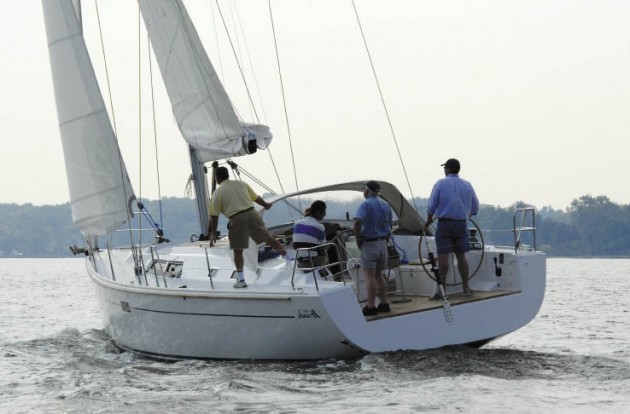 As we motored into Back Creek, the Yanmar did a great job, easily pushing the hull over 6 knots. The new series of Yanmars run smooth and quiet, are very fuel efficient and have very low emissions. The sound level was very low; Hanse did a great job on the engine room insulation.
As we motored into Back Creek, the Yanmar did a great job, easily pushing the hull over 6 knots. The new series of Yanmars run smooth and quiet, are very fuel efficient and have very low emissions. The sound level was very low; Hanse did a great job on the engine room insulation.
Hanse is breaking the rules and a lot of people are taking notice. The company is selling boats as fast as it can build them. A nicely equipped 430e in sailaway condition sells for around $315,000. Look for a new Hanse in your harbor soon.

Comments